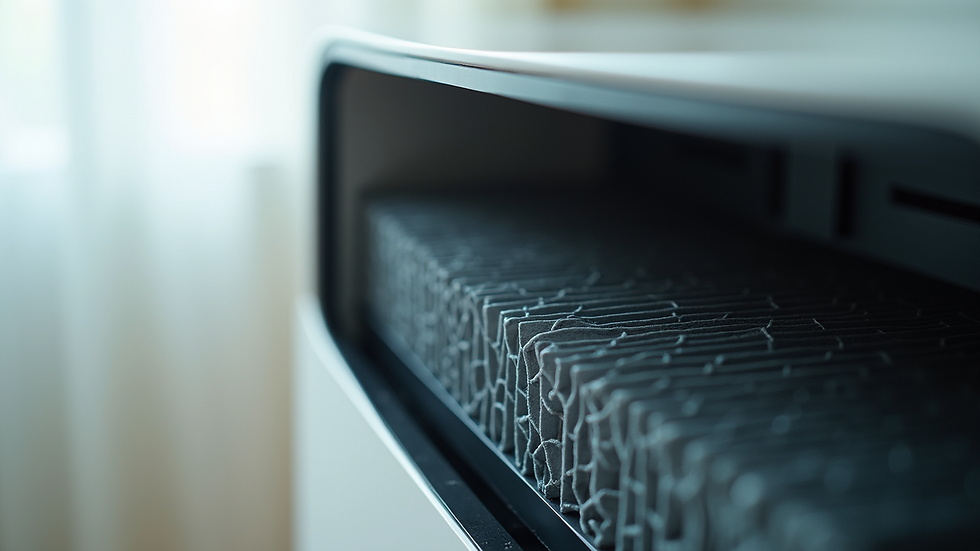Are Air Purifiers the Solution for Cleaner Indoor Air in Pakistan?
- Mustafa Rahman
- Mar 16, 2025
- 3 min read
Indoor air quality is becoming a significant concern in Pakistan, particularly in bustling urban areas. As cities grow and industry flourishes, pollutants infiltrate our atmosphere. Air purifiers are now in the spotlight as potential tools to improve indoor air quality. This blog examines the effectiveness of air purifiers in providing cleaner indoor air in homes and offices throughout Pakistan.
The Importance of Indoor Air Quality
As the population increases, cities like Lahore and Karachi grapple with serious air pollution challenges. Key contributors include vehicle emissions, factory discharges, and construction dust.
Healthy indoor air quality (IAQ) is essential since people average 90% of their time indoors. Poor IAQ can lead to respiratory problems, allergies, and more severe health issues. For instance, a study indicated that children living in polluted areas are 33% more likely to develop asthma compared to those in cleaner environments. This makes improving indoor air critical for everyone's health, especially for vulnerable groups like children and the elderly.
Understanding Air Purifiers
Air purifiers work by filtering out harmful pollutants and contaminants from indoor air. They use various technologies, including HEPA filters, activated carbon, and ionizers, to capture particles, allergens, and harmful gases.
The effectiveness of an air purifier largely depends on its technology. For instance, HEPA filters can capture 99.97% of particles as small as 0.3 micrometers, making them highly effective against dust, pollen, and pet dander. In practical terms, this means that an air purifier with a HEPA filter can drastically reduce exposure to common allergens found indoors.

The Air Quality Issues in Pakistan
Air pollution has reached alarming levels in Pakistan, leading to health crises across the country. The World Health Organization (WHO) ranks several cities in Pakistan among the world’s most polluted.
The major sources of pollution include vehicle emissions, industrial activities, and seasonal practices like crop burning. During winter months, cities often experience heavy smog, highlighting the need for effective measures to address indoor air quality.
Can Air Purifiers Help?
Air purifiers can be a practical addition to homes, particularly in areas with high pollution levels. For example, an air purifier can reduce airborne contaminants by up to 50% within hours of use. However, it's crucial to remember that air purifiers are not a complete solution to indoor air quality issues.
While they effectively filter harmful particles, additional practices like adequate ventilation and regular cleaning are essential to maintain a healthy indoor space.
Key Considerations Before Buying an Air Purifier
Filter Types: Air purifiers with HEPA filters are invaluable for capturing allergens. Adding activated carbon filters helps eliminate odors and volatile organic compounds (VOCs).
Room Size: Choose a purifier that suits the room’s dimensions. Each unit is rated by its Clean Air Delivery Rate (CADR), which shows how effectively it cleans the air in a specific space.
Real-Life Benefits of Using Air Purifiers
Users frequently report positive changes in their indoor air quality after using air purifiers. Common benefits include:
Reduced Allergies: Air purifiers effectively capture allergens from pets, dust, and pollen, helping to alleviate allergic reactions.
Better Sleep: Breathing cleaner air often leads to improved sleep quality, which can enhance overall productivity and wellness.
Odor Elimination: Purifiers equipped with activated carbon filters can effectively neutralize unwanted odors from cooking, pets, and tobacco smoke.
Limitations of Air Purifiers
Despite their advantages, air purifiers are not all-powerful. They cannot eliminate every pollutant, nor can they fully address outdoor air quality concerns.
Also, relying solely on air purifiers can lead to neglect of other vital practices for maintaining clean indoor air, such as regular dusting and vacuuming.
Air Quality Regulations and Standards in Pakistan
Pakistan faces obstacles in enforcing strict air quality regulations. Urban areas continue to deal with pollution challenges without comprehensive measures in place.
Several organizations are striving to implement air quality monitoring systems to establish a foundation for pollution control. As these initiatives gain traction, public awareness about the importance of clean air is expected to grow. This, in turn, can encourage more people to use air purifiers and adopt other practices to improve indoor air quality.
A Path Toward Cleaner Indoor Air
As air quality declines in many regions of Pakistan, the role of air purifiers in enhancing indoor environments cannot be overlooked. They offer significant benefits by filtering harmful particles, but they should be part of a broader strategy to tackle indoor air pollution.
Combining good ventilation, consistent cleaning practices, and the use of air purifiers can lead to a healthier indoor atmosphere. It is vital for individuals to take initiative in addressing air quality issues in their homes by making informed choices about their air purification options.
The journey toward cleaner indoor air in Pakistan may be challenging, but with increased awareness and the use of effective solutions, meaningful progress can be achieved.


Comments